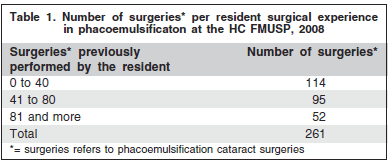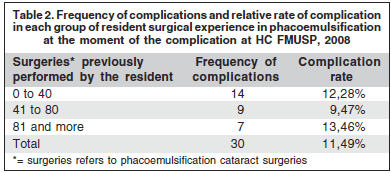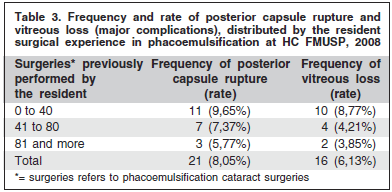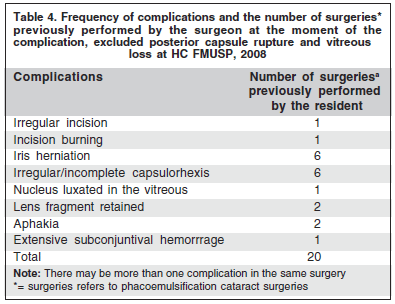

Pedro Carlos Carricondo1; Ana Carolina Freitas Morais Fortes2; Paula de Carvalho Mourão2; Marcelo Hajnal2; Newton Kara Jose3
DOI: 10.1590/S0004-27492010000100012
ABSTRACT
PURPOSE: To analyse the outcomes of surgeries performed by senior residents during the learning curve related to intraoperative complications and staff interventions. METHODS: Prospective study of phacoemulsification surgeries performed by senior residents (3rd year) in the first three months of experience with this technique at the HC FMUSP. Intraoperative complications and requirement of staff interventions were measured. RESULTS: 261 surgeries were included. 30 cases of intraoperative complications were noted (11.54%). Major complications, that could affect surgical final results, as posterior capsule rupture and vitreous loss, had an incidence rate of 8.05% and 6.13%, respectively. Surgery was converted to cataract extracapsular extraction in 3 cases and 2 cases required pars plana posterior vitrectomy. Staff intervention was required in 11 cases (4.22%), most of them on the first 40 surgeries. CONCLUSION: With proper training and supervision, senior residents can achieve an acceptable complication rate. Adequate supervision is crucial to guarantee, good surgical outcomes, specially on the first 40 cases, that presents greater complications rates.
Keywords: Cataract extraction; Learning; Inservice training; Ophthalmologic surgical procedures; Internship and residency
RESUMO
OBJETIVO: Analisar a curva de aprendizado dos residentes do 3º ano, com experiência prévia em microcirurgia e cirurgia intraocular, em facectomia por facoemulsificação relacionada às complicações peroperatórias e ao número de intervenções diretas do orientador. MÉTODOS: Foi realizada análise prospectiva de cirurgias de facectomia por facoemulsificação realizadas durante os três primeiros meses de treinamento do residente do 3º ano do HC FMUSP nesta técnica. Foram registradas as complicações ocorridas durante o ato operatório e a necessidade do orientador intervir diretamente na cirurgia. RESULTADOS: Foram incluídas 261 cirurgias. Destas, tiveram algum tipo de complicação peroperatória 30 cirurgias (11,54%). Complicações mais graves, com potencial para prejudicar o resultado final da cirurgia, em especial rotura de cápsula posterior e perda vítrea, tiveram um índice de 8,05% e 6,13%, respectivamente. Houve necessidade de conversão para facectomia extracapsular em 3 cirurgias e de vitrectomia posterior em 2 casos. O orientador interveio diretamente na cirurgia em 11 ocasiões (4,22%), concentradas em sua grande maioria nas 40 primeiras cirurgias. CONCLUSÃO: Com treinamento e supervisão adequados, taxas de complicações aceitáveis podem ser obtidas por residentes sênior no aprendizado da facoemulsificação. Adequada assistência é imprescindível para garantir o resultado das cirurgias especialmente na fase em que os residentes têm maiores taxas de complicação, correspondente às 40 primeiras cirurgias.
Descritores: Extração de catarata; Aprendizagem; Capacitação em serviço; Procedimentos cirúrgicos oftalmológicos; Internato e residência
ORIGINAL ARTICLE
Senior resident phacoemulsification learning cure
Curva de aprendizado do residente de terceiro ano em facoemulsificação
Pedro Carlos CarricondoI; Ana Carolina Freitas Morais FortesII; Paula de Carvalho MourãoIII; Marcelo HajnalIV; Newton Kara JoseV
IAssistant Practioner - Department of Ophthalmology Doctoral Student - Clinical Hospital - University of São Paulo School of Medicine - USP - São Paulo - Brazil
IICataract Service Fellow, Department of Ophthalmology Clinical Hospital - University of São Paulo School of Medicine - USP - São Paulo - Brazil
IIICataract Service Fellow, Department of Ophthalmology Clinical Hospital - University of São Paulo School of Medicine - USP - São Paulo - Brazil
IVCataract Service Fellow, Department of Ophthalmology Clinical Hospital - University of São Paulo School of Medicine - USP - São Paulo - Brazil
VEmeritus professor - Department of Ophthalmology -Clinical Hospital - University of São Paulo School of Medicine - USP - São Paulo - Brazil
ABSTRACT
PURPOSE: To analyse the outcomes of surgeries performed by senior residents during the learning curve related to intraoperative complications and staff interventions.
METHODS: Prospective study of phacoemulsification surgeries performed by senior residents (3rd year) in the first three months of experience with this technique at the HC FMUSP. Intraoperative complications and requirement of staff interventions were measured.
RESULTS: 261 surgeries were included. 30 cases of intraoperative complications were noted (11.54%). Major complications, that could affect surgical final results, as posterior capsule rupture and vitreous loss, had an incidence rate of 8.05% and 6.13%, respectively. Surgery was converted to cataract extracapsular extraction in 3 cases and 2 cases required pars plana posterior vitrectomy. Staff intervention was required in 11 cases (4.22%), most of them on the first 40 surgeries.
CONCLUSION: With proper training and supervision, senior residents can achieve an acceptable complication rate. Adequate supervision is crucial to guarantee, good surgical outcomes, specially on the first 40 cases, that presents greater complications rates.
Keywords: Cataract extraction/education; Learning; Inservice training; Ophthalmologic surgical procedures/education; Internship and residency
RESUMO
OBJETIVO: Analisar a curva de aprendizado dos residentes do 3º ano, com experiência prévia em microcirurgia e cirurgia intraocular, em facectomia por facoemulsificação relacionada às complicações peroperatórias e ao número de intervenções diretas do orientador.
MÉTODOS: Foi realizada análise prospectiva de cirurgias de facectomia por facoemulsificação realizadas durante os três primeiros meses de treinamento do residente do 3º ano do HC FMUSP nesta técnica. Foram registradas as complicações ocorridas durante o ato operatório e a necessidade do orientador intervir diretamente na cirurgia.
RESULTADOS: Foram incluídas 261 cirurgias. Destas, tiveram algum tipo de complicação peroperatória 30 cirurgias (11,54%). Complicações mais graves, com potencial para prejudicar o resultado final da cirurgia, em especial rotura de cápsula posterior e perda vítrea, tiveram um índice de 8,05% e 6,13%, respectivamente. Houve necessidade de conversão para facectomia extracapsular em 3 cirurgias e de vitrectomia posterior em 2 casos. O orientador interveio diretamente na cirurgia em 11 ocasiões (4,22%), concentradas em sua grande maioria nas 40 primeiras cirurgias.
CONCLUSÃO: Com treinamento e supervisão adequados, taxas de complicações aceitáveis podem ser obtidas por residentes sênior no aprendizado da facoemulsificação. Adequada assistência é imprescindível para garantir o resultado das cirurgias especialmente na fase em que os residentes têm maiores taxas de complicação, correspondente às 40 primeiras cirurgias.
Descritores: Extração de catarata/educação; Aprendizagem; Capacitação em serviço; Procedimentos cirúrgicos oftalmológicos/educação; Internato e residência
INTRODUCTION
Cataract surgery is the most common surgical procedure performed around the world, which reflex the fact that cataract is the first cause of blindness in the world. Population aging is making the needs for cataract surgery raise exponentially around the world(1).
Residency curriculum reflects this fact. Cataract is the core procedure for training residents. Nowadays, phacoemulsification cataract surgery has become the preferred technique, because of its safety, faster recovery and reproducibility(2).
There are some issues on when to start the training in phacoemulsification surgery. On the one hand, it is desirable to the surgeon to have previously experience in micro and intraocular surgery. On the other hand, up to 10% of the residents may experience troubles in developing surgical skills(3) and the later the training, less the time to specially training and supervise distressed surgeons.
Learning process complications are a point of major concern, due to the concernment with patients safety(4). The learning curve of phacoemulsification performed by residents shows a higher number of complications(5-6) in the first cases, that decreases while experience increases. Thereafter, complications rates are considered acceptable, with good visual results(4,7-10) in the long term.
In the cataract surgery teaching program of the Department of Ophthalmology of Clinical Hospital of University of São Paulo School of Medicine (HC FMUSP), cataract surgery by phacoemulsification technique is performed by senior residents (3rd year), who have fairly experience in microsurgery and intraocular surgery by performing first wet labs and other procedures as part of the curriculum (at least 50 extracapsular cataract extraction and 20 pterygium excision with conjunctival autograft), besides watching more than 100 phacoemulsification procedures. This method is similar to the preferred practice pattern in resident-performed cataract surgeries of the United States residency programs(2).
Resident-performed cataract surgeries have a high potential for complications. Factors that can predict complications are: dense / white / mature / brunescent cataract, nuclear grading 1+, high refraction errors (eyes >27 mm or <20 mm), zonule weakness, pseudoexfoliation, posterior synechiae, shallow anterior chamber, corneal cloudiness, previous surgery, severe patient anxiety, unability to lie flat(11-12), polar posterior cataract(13), traumatic cataract and first 80 phacoemulsification surgery(10). Attention must be paid to preoperative patient selection. Such cases should not be assigned to training surgeons.
The aim of this study is to report the phacoemulsification learning curve of senior residents. Intraoperative complications and requirement of staff interventions were measured in the first 3 months of experience of phacoemulsification cataract surgery technique.
METHODS
A prospective study was conducted in the outpatient surgical room of the HC FMUSP in the 3 first months of residents phacoemulsification learning curve, between May/08 and July/08. All resident-performed cataract surgeries that did not meet any exclusion criteria: previous surgery, "special" cataracts (traumatic cataract, polar posterior cataract, total cataract, etc), another ocular disease, like glaucoma, uveites and corneal opacities, insuficient mydriasis, eyes with orbital hardship and only eye were included.
The residents performed phacoemulsification with a relatively uniform technique in all cases. While patients were under topical or local (peribulbar block) anesthesia, residents performed clear cornea incisions. A continuous curvilinear capsulorrhexis was performed. The lens was then phacoemulsified, usually with the "stop-and-chopp" technique. When possible, foldable acrylic intraocular lenses were inserted into the capsular bag.
Trained fellows registered the surgeries (from Monday to Thursday) performed by the residents. The residents changed the surgical day, according to a previous curriculum schedule. The registration included complications, resolution and requirement of intervention by the staff-attending doctor. Residents case number was established by asking each resident all phacoemulsification cases performed at all facilities chronologically and then assigning each case its sequential number. Thus, the case numbers used for analysis reflect the actual experience of the individual resident performing the surgery rather than the exact sequential order of cases performed at the institution during the study period.
The data collected are registered and analyzed in a Microsoft Excel® database.
All the patients signed the informed consent form. The institution Investigational Review Board approved the study.
RESULTS
261 surgeries were eligible for the study 14 third year residents performed the operations. Table 1 shows the number of surgeries per resident surgical experience.

Table 2 shows the absolute number of complications and the relative rates at each surgical experience group. In this study, an overall complication rate of 11.54% was found.

Table 3 shows the incidence of major complications with potential postoperative visual acuity impairment; posterior capsule rupture and vitreous loss. Table 4 shows general complications, other than the major ones.


Staff surgeon performed a direct intervention in 11 surgeries (4.23%). At the moment that the resident performed less than 40 surgeries, the rate of staff major intervention was 7.89% (9 surgeries). After that, only 2 surgeries required the supervisor direct intervention to resolve complications.
Conversion to less extracapsular extraction was indicated in 3 cases and pars plana posterior vitrectomy in another 2 cases. There were 2 cases of aphakia, one case of luxated nucleus to the vitreous cavity and 16 cases of vitreous loss.
DISCUSSION
Surgical skills learning can be one of the greatest challenges of the residency training. The trainees must develop cognitive knowledgement, dexterity and tridimensional appreciation of the eye anatomy(1). Among the eye surgeries, the phacoemulsification is considered one of the most difficult to master(1,4).
In the HC FMUSP, a progression from theoretical readings to wet labs practice and ultimate participation in surgeries is proposed. After a theoretical course of two months, the first year resident starts a preparation for microsurgery training suture in surgical gloves at the microscope. When mastering the technique, they are authorized to make extraocular microsurgeries, like pterygium with conjunctival autograft. At the end of the first year and through the second year, intraocular surgery is introduced. At least 50 extracapsular cataract extractions are performed. Throughout the year, the residents are encouraged to take some hours at the wet lab, performing some phacoemulsification surgery in pig eyes. At the end of the second year, the teaching of phacoemulsification starts. Because every step in phacoemulsification must be satisfactorily performed to easily make the next step, the resident must master most of the steps at the time he begins the learning of phacoemulsification cataract surgery(1,4,7). In the first surgeries, the resident has a full time supervision by a staff experienced cataract surgeon. It is recommended by the Accreditation Council of Graduate Medical Education (ACGME) at least 80 phacoemulsification cataract surgery to be done in the learning curve(10). Most of the residents in this study achieved more than 100 surgeries in the first 3 months.
The complication rate is accepted as a parameter that reflects the phacoemulsification learning curve(14-17). The chances of experiencing a complication decrease by 1% with each successive case during training(17).
Few studies show the general complication rate. Most of them points out just the vitreous loss rates. The incidence of complication in resident-performed surgeries or junior trainees ranged from 1.8% to 27.4%(5-6,8-10,14-15,18). As expected, a decrescent major complications rate was noted with the progressing experience of the surgeon. There was a small elevation in the overall complication rate after the 80th surgery, fortunately due to minor complications that do not compromise the final surgery results and could be managed by the resident himself.
The rate of major complications that can affect the final results with visual acuity loss, posterior capsule rupture(19) and vitreous loss(8) was low and coincident with other previous literature relates. There were reports of vitreous loss incidence as high as 14.7% with phacoemulsification in anterior chamber(5). Residents are more than twice likely to loose vitreous during their first 80 cases than in their last 80 cases(10). Vitreous loss incidence ranged from 8.77% before 40 surgeries to 3.85% after completing 80 surgeries in this study.
The percentage of phacoemulsification performed exclusively by the residents, or the completion rate, should also be considered as another critical aspect in resident surgical training. In a patient-based practice, most supervisors will try their best to avoid a high complication rate of the trainee surgeon(14). The supervisors could prevent some dangerous or inappropriate movements, or take over the surgery if potentially serious complications occurred(14). Their active or passive attitude in the intervention of the surgery somewhat modifies the incidence of complications and only this parameter could not reflect the real acquisition of the skills in the phacoemulsification(14). Therefore, surgical results of the trainees should not be evaluated solely on the complication rate. The method of evaluation the learning curve by the completion rate was recently proposed and showed a rate of 44.7% of completion(14) in the United States. In this study, a very high rate of completion was found: 95.77% of surgeries being finished by the resident. The need of direct surgeon intervention was low and concentrated on the first surgeries. Before the resident had completed 40 surgeries, as presumed, the completion rates were lower, 92.11%, with the attending surgeon taking over 7.89% of the surgeries. The residents resolved most of the complications with no need of the attending staff taking over the surgery. The number of surgeries completed in a whole by the trainees at this study was very high.
CONCLUSION
In this study, major complications related to resident-performed phacoemulsification with previous experience in micro and intraocular surgery presented a low incidence. The training surgeons, without the need of staff major intervention managed most of complications. Adequate supervision is essential to guarantee good surgical results, specially in the first 40 cases, that presents greater complications rates.
REFERENCES
1. Henderson BA, Ali R. Teaching and assessing competence in cataract surgery. Curr Opin Ophthalmol. 2007;18(1):27-31.
2. Rowden A, Krishna R. Resident cataract surgical training in United States residency programs. J Cataract Refract Surg. 2002;28(12):2202-5.
3. Binenbaum G, Volpe NJ. Ophthalmology resident surgical competency: a national survey. Ophthalmology. 2006;113(7):1237-44. Comment in: Ophthalmology. 2006;113(12):2380-1. Ophthalmology. 2007;114(4):829-30; author reply 830.
4. Dooley IJ, O'Brien PD. Subjective difficulty of each stage of phacoemulsification cataract surgery performed by basic surgical trainees. J Cataract Refract Surg. 2006;32(4):604-8.
5. Allinson RW, Metrikin DC, Fante RG. Incidence of vitreous loss among thirdyear residents performing phacoemulsification. Ophthalmology. 1992;99(5): 726-30. Comment in: Ophthalmology. 1992;99(8):1181. Ophthalmology. 1992; 99(10):1481-2.
6. Allinson RW, Palmer ML, Fante R, Stanko M. Vitreous loss during phacoemulsification by residents. Ophthalmology. 1992;99(8):1181.
7. Lee AG, Greenlee E, Oetting TA, Beaver HA, Johnson AT, Boldt HC, et al. The Iowa ophthalmology wet laboratory curriculum for teaching and assessing cataract surgical competency. Ophthalmology. 2007;114(7):e21-6.
8. Blomquist PH, Rugwani RM. Visual outcomes after vitreous loss during cataract surgery performed by residents. J Cataract Refract Surg. 2002;28(5):847-52.
9. Corey RP, Olson RJ. Surgical outcomes of cataract extractions performed by residents using phacoemulsification. J Cataract Refract Surg. 1998;24(1):66-72. Comment in: J Cataract Refract Surg. 1998;24(6):727-9.
10. Randleman JB, Wolfe JD, Woodward M, Lynn MJ, Cherwek DH, Srivastava SK. The resident surgeon phacoemulsification learning curve. Arch Ophthalmol. 2007;125(9):1215-9. Comment in: Arch Ophthalmol. 2008;126(11):1608; author reply 1609.
11. Muhtaseb M, Kalhoro A, Ionides A. A system for preoperative stratification of cataract patients according to risk of intraoperative complications: a prospective analysis of 1441 cases. Br J Ophthalmol. 2004;88(10):1242-6. Comment in: Br J Ophthalmol. 2004;88(10):1231-2.
12. Osborne SA, Severn P, Bunce CV, Fraser SG. The use of a pre-operative scoring system for the prediction of phacoemulsification case difficulty and the selection of appropriate cases to be performed by trainees. BMC Ophthalmol. 2006;6:38.
13. Osborne SA, Adams WE, Bunce CV, Fraser SG. Validation of two scoring systems for the prediction of posterior capsule rupture during phacoemulsification surgery. Br J Ophthalmol. 2006;90(3):333-6.
14. Lee JS, Hou CH, Yang ML, Kuo JZ, Lin KK. A different approach to assess resident phacoemulsification learning curve: analysis of both completion and complication rates. Eye (Lond). 2009;23(3):683-7.
15. Badoza DA, Jure T, Zunino LA, Argento CJ. State-of-the-art phacoemulsification performed by residents in Buenos Aires, Argentina. J Cataract Refract Surg. 1999;25(12):1651-5. Comment in: J Cataract Refract Surg. 2000;26(6): 794-5.
16. Prasad S. Phacoemulsification learning curve: experience of two junior trainee ophthalmologists. J Cataract Refract Surg. 1998;24(1):73-7.
17. Robin AL, Smith SD, Natchiar G, Ramakrishnan R, Srinivasan M, Raheem R, Hecht W. The initial complication rate of phacoemulsification in India. Invest Ophthalmol Vis Sci. 1997;38(11):2331-7.
18. Tayanithi P, Pungpapong K, Siramput P. Vitreous loss during phacoemulsification learning curve performed by third-year residents. J Med Assoc Thai. 2005; 88(Suppl 9):S89-93.
19. Johansson B, Lundström M, Montan P, Stenevi U, Behndig A. Capsule complication during cataract surgery: Long-term outcomes: Swedish Capsule Rupture Study Group report 3. J Cataract Refract Surg. 2009;35(10):1694-8.
 Correspondence address:
Correspondence address:
Pedro Carricondo
Rua Santa Cruz, 805/72
São Paulo (SP) CEP 04121-000
E-mail: [email protected]
Recebido para publicação em 08.10.2009
Última versão recebida em 08.11.2009
Aprovação em 12.12.2009
Study carried out at Department of Ophthalmology -Clinical Hospital of University of São Paulo School of Medicine - USP.
Nota Editorial: Depois de concluída a análise do artigo sob sigilo editorial e com a anuência da Dra. Mônica de C. Alves Paula sobre a divulgação de seu nome como revisora, agradecemos sua participação neste processo.